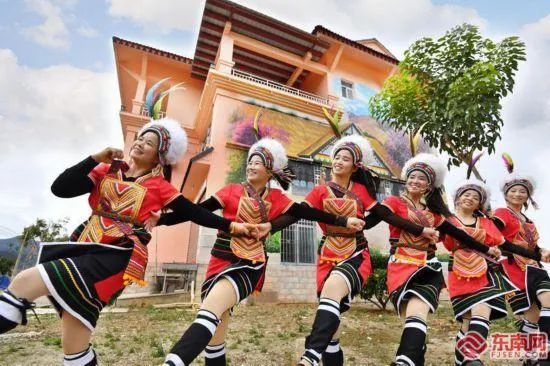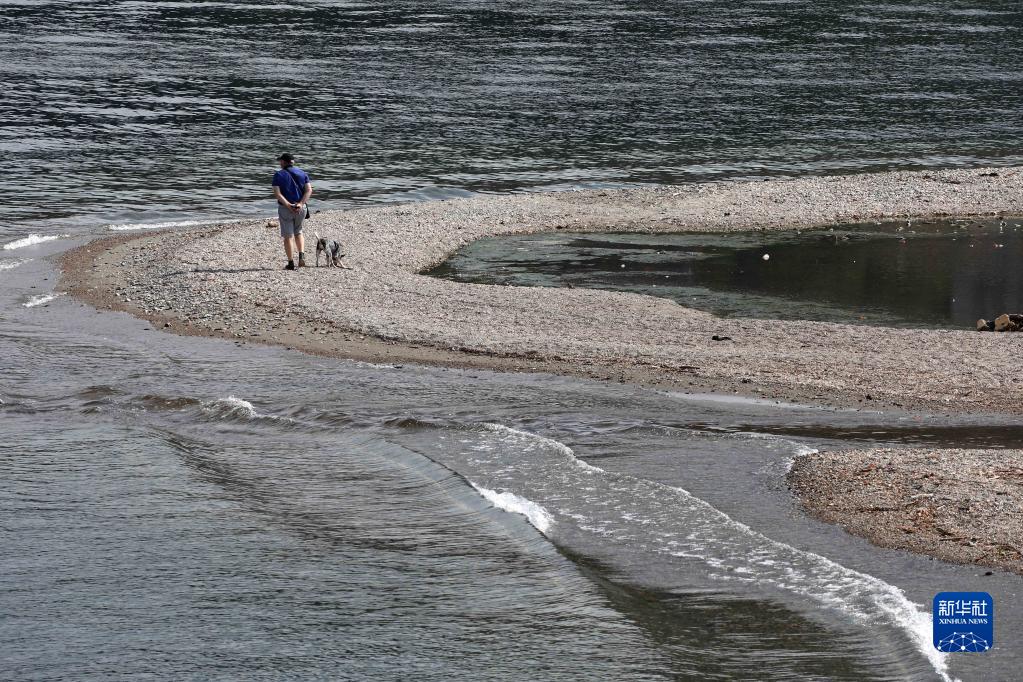Alpine settlement: Baiyue Realm across the strait 丨 Chinese architectural culture
Author:China National News Time:2022.07.21
The alpine people are mainly living in Taiwan, and there are a few scattered in Fujian and Zhejiang. The alpine people are dominated by rice farming economy, supplemented by fishing and hunting production. Due to the different geographical environment of the living area, the layout and architectural form of the Gaoshan people's living villages are different.

In the ethnic minority villages in Xiandu Town, Hua'an County, Zhangzhou City, Fujian Province, the villagers of the Gaoshan ethnic group dressed in colorful national costumes and danced cheerful dances to welcome guests in Bayang to visit the newly built village. Fujian Daily reporter/Photo by Lin Hui
Alpine settlement: Fujian and Taiwan Tonggen
Fujian and Taiwan are across the sea, which is roughly in the same latitude. The climate and terrain are extremely similar. At the same time, there are many mountains in the Fujian and Taiwan regions. The diverse landscape landforms and the pleasant climate environment nurtured the children of Fujian and Taiwan, accumulated deep historical culture, and formed a distinctive regional Fujian -Taiwan culture.
For a long time, the people of Fujian and Taiwan have reproduced in a similar environment to form a similar settlement space form, showing the characteristics of the location of the residence adapted according to local conditions.
Affected by the terrain and the basin, the alpine settlements are mostly distributed in the low mountain hills, river buildings, and sea accumulation plains along the river. They have typical watershed characteristics, and the scale of the settlement is generally small. The coastal areas use superior water transportation conditions to build along the river to facilitate transportation and farming irrigation. The climate conditions in the coastal areas have made the environmental adaptability of the alpine settlements. The settlement is mostly built on the hillside or highlands, and the mountains are mostly on the mountains. The construction of residential houses focuses on moisture -proof, waterproof, sun protection, and ventilation. The roof shape is mostly considered to drain the roof. The eaves are deeper, and there is room for activity under the eaves. The orientation in the settlement also takes into account the impact of the direction of monsoon, forming the characteristics of blocking cold flow and absorbing warm currents. Due to the influence of typhoons in coastal areas, the settlers are mostly used as the main construction materials, and the advantages of rich inland forest resources have also promoted the development of the construction system of rammed civil engineering.
Dry Laoso: Baiyue Same Source
The early dwellings of the Takayama people were rich in style, including half -cars of residential buildings, dry -rail -up buildings, slate houses, etc. The most typical and popularity of them was dry -column buildings. Tta, slate, and bamboo and wood were the main construction materials.
The Taiwan Island and Hainan Island are affected by the marine climate. The ground is humid and there are many species. Therefore, the living environment of the people of the Gaoshan and the Li people is very similar. At the same time, the Li and Takayama people belonged to the descendants of the ancient Baiyue people. They migrated from the ancient Baiyue area along the southeast coast to these two islands. After continuous development and change, they still maintained some ancient architectural forms. Whether it is the early dry -column building of the Li ethnic group or the Gaoshan tribe -style houses, it has obvious Baiyue cultural characteristics.
The dry -column housing of the Gaoshan tribe is usually divided into two floors. Generally, wood and bamboo materials are made of piles, slabs, and upper floor walls. The lower layers are not covered. The walls are also built from the ground with bricks, stones, and mud.
The "Fanxia Caifeng Map" in the Qing Dynasty depicts the dry -column -type buildings of the Takayama clan. The roof is covered with bark, thatched grass or pottery tiles. In the Qing Dynasty's "Rebuilding Fengshan County", there were also about the "residence of the alpine, the name of the house was" Lang ". Building soils as the base, bamboo as a beam, 葺 清 清 清, editing bamboo as a wall, and weaving as the door" " Records, this is very similar to the Li's dry -column -type building.
Finding root and casting soul: colorful interpretation of contemporary architecture
In Taiwan, some contemporary buildings have absorbed the traditional architectural culture and regional characteristics of the alpine people, thereby expressing the intention of the landscape. The architects mostly use the surrounding environment of the building as the starting point. The building shape comes from the landscape elements such as mountains, sea, reefs, etc., making the building and the surrounding environment organically integrate, or become a landscape building, or reflect the characteristics of the terrain.
Taking the Lanyang Museum designed by Yao Renxi as an example, it is based on the concept of the unilateral single -sided mountain characteristics of the northern coast of Yilan, the construction body of the building as the "mountain", and the landscape wetland as "water" to create a building style of blending landscape. Jane's geometric shape reproduces Lanyang's unique history, culture and topography.

Lanyang Museum, Yilan County, Taiwan. Jinxin confessed
In addition, there are some contemporary buildings in Taiwan who use the cultural elements of Takayama as architectural elements and sources of creation, and integrate into building space and activity scenes in various ways. For example, the Gaoshan Handicraft Promotion Center located in Hualien, in terms of curatorial, cultural, creative, food, music, etc., and placed with modern architectural spaces to highlight the regional characteristics, it also makes the Gaoshan culture rejuvenating new vitality.
It can be said that the architectural culture of the Gaoshan nationality is an important part of the architectural culture in Taiwan, and it is an important source of Taiwan's regional architectural design and creation. In the long -term production and life practice, the people of the Gaoshan people adapted to the living culture of the same roots as the people of the southeast coastal areas according to local conditions, and jointly established a beautiful home of the people on both sides of the strait.
Author unit: Southeast University's Chinese National Visual Image Research Base. This article is the research results of the National Social Science Foundation "Casting the Chinese Nation Community Awareness" research special "Analysis of the Visual Image Category Analysis of the Chinese Nation Community" (project number 20VMZ008).
Source: China National News
- END -
Italy: Lake Komo, who encountered drought

On July 13, in Komo, the major district of Lunba, Italy, the man walked the dog by...
A group of young people made Tangqi a "common fruit"

The sunset of Jin Chancan was sprinkled on the road of Yaojiaxu Village, Hangzhou,...